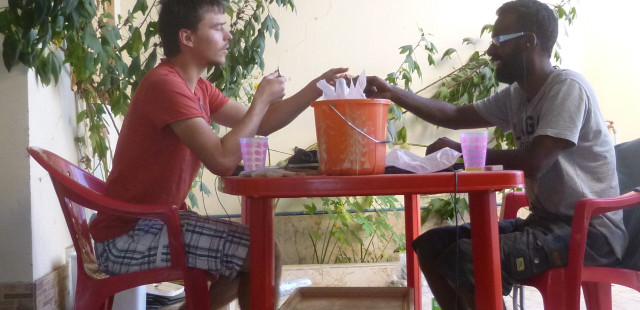The BFSA kindly awarded me a grant at the end of 2013 which enabled me to visit Oman in early 2014 in order to carry out an investigative season for a new historical archaeology project I am hoping to establish. Bat, Al-Khutm and Al-Ayn together make up one of four UNESCO World Heritage sites in Oman, inscribed on the basis of the extraordinary Bronze Age funerary monuments both at Bat and Al-Ayn, and the monumental Bronze Age ‘towers’ at Bat and Al-Khutm. The modern town of Bat is adjacent to the World Heritage zone and is an oasis where date palms are cultivated, at the heart of which is the old (now abandoned) mud brick village, clustered round the central fortified tower or Husn. Such mud brick villages within oases represent an important part of rural life right up until the mid-1970s when modernisation based on oil production resulted in sudden sweeping change. All Omani residents were required to build new houses of modern materials (concrete breeze blocks dominate) and abandon the old fashioned mud brick houses permanently. This wholesale change was intended to signal both to Omanis and to international observers that Oman was a modern country, and as such, must have had a huge impact on community and individual identity, and also on community and family relationships.
The aim of this new project is to explore the creation and reproduction of socio-political power structures and systems within the abandoned village, through the analysis of material culture and informant interview. Exploring these villages in terms of material culture and the direct memories and understandings of people who lived in them offers an opportunity to learn about the ways in which people used space and architecture to shape and create individual, family, tribal, political, religious and other relations within the villages. It also allows us to explore how they dealt with any dislocation resulting from government initiated mass re-settlement programmes.
In this first short (three and a half week) field season a small team dedicated to this historical archaeology project were able to achieve a great deal. We created an initial plan of the village, began analysing and recording walls of the extant buildings, interviewed fourteen people who had lived in the village and conducted site visits, excavated in one of the houses and obtained an artefact assemblage. We also held an open day for the people of Bat to come and see the excavations and learn about the wider project aims, and over 100 visitors attended. Men were scheduled to visit during the morning and women in the afternoon, and many of the women brought along mats, food and tea and set up picnics in the alley way immediately outside the house where we were excavating, thus turning the occasion into a very social one as well. Everyone who visited said they were pleased to be able to learn about our project, and many people told us they were pleased and proud that their village and their past was being studied like this.
Thanks to all the team members (Owen Batchelor, Katherine Dance, Angie Hume, Hannah Hunt, Adil Riaz, Shadia Taha,) and AJBAP, and the people of Bat, and to Ms Samia al-Shaqsi, Ms Asma al-Jassassi, Mr Sulieman (Oman Ministry of Heritage and Culture, Bat), Mr Neil De Leon (Surveyor, Oman Ministry of Heritage and Culture), Mr Sultan Albakri (Director of Excavations and Archaeological Studies, Oman Ministry of Heritage and Culture, Muscat), and to the British Foundation for Arabian Studies.
(Photo: Bat: excavation in an abandoned shop)





